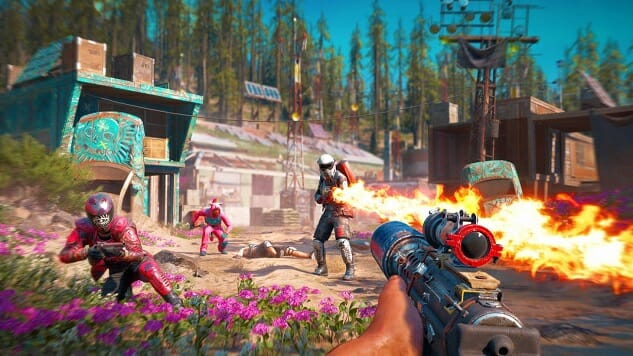Far Cry New Dawn Is Far Cry on a Smaller Scale

Exactly what is Far Cry? In an industry that all but insists on building games around a marketable genre, often a series or a game will lose its original identity as external pressure to conform to a single, profitable vision mounts over time. In the case of Far Cry, the last installment introduced some major upsets to some of the series’s most key identifying features, leaving some, like myself, to wonder what is exactly the point of playing a Far Cry game. Is it an open world exploration game? Is it a shooting game? Is a hunting game? Is it a game about taking outposts and gaining territory? It’s difficult to figure out what the developers imagine its primary purpose to be because the focal point so often wanders. With the release of the sequel to Fall Cry 5, now seems as good a time as any to assess. What is being emphasized, and what is being left behind?
Far Cry New Dawn is like Far Cry Primal in that it takes a lot of existing Far Cry assets and reconfigures them in a way that I find impressive. Game development is an expensive business, and creatively repackaging Hope County with a fresh coat of post-apocalyptic paint is, from a practical perspective, a stroke of brilliance. I like the feeling of returning to familiar places post-disaster (it’s one of the many reasons I love the Fallout series) and this new spin, which sees the protagonist rebuilding a settlement of survivors following the apocalypse at the end of Far Cry 5, gives the developers a chance to take some liberties with the setting without threatening the series’s core basis in pseudo-reality. The results are gorgeous. The buried ruins, vibrant overgrowth and purple wildflowers that spread throughout Hope County are a welcome facelift on a familiar setting.
It’s this same narrative sleight of hand that seems to point Far Cry New Dawn towards a focus on outposts and territorial expansion. The main goal, as the game progresses, is to build up your own base as you gather resources, conquering outposts for the necessary fuel and ransacking old buildings for crafting components. It’s a practical consideration that surprisingly makes much more sense than that of the several games past. The player character’s motivation, to upgrade the survivor settlement of Prosperity and rebuild society, is sympathetic, and provides more explanation for the game’s primary conceit than the one-person-army power fantasies from before. It also provides a jumping off point for some of the most thoughtful writing in the series. While the over-the-top antics of Far Cry are usually supplanted by NPCs who, even when they are on the “right side” of the game’s central conflict, tend to come off as caricatures rather than real people, in New Dawn the writing is more subdued in favor of supporting its themes of post-disaster cooperation. This leads to a few performances and storylines, particularly the Ryes’, that are very humanizing. This is the first Far Cry game with any sense of continuity, and Far Cry New Dawn is much better off for it. The most intriguing parts of the game are spent following up on the events of Fall Cry 5, and the emotional investment I felt during some of the story’s pivotal moments highlights just how detached and trivial the plotlines of the preceding games really are. While I expected New Dawn to take a more neutral or nihilistic position with the protagonist’s role, I was pleasantly surprised. After all these years, it’s nice to see a Far Cry protagonist unambiguously play the hero.
-

-

-

-

-

-

-

-

-

-

-

-

-

-

-

-

-

-

-

-

-

-

-

-

-

-

-

-

-

-

-

-

-

-

-

-

-

-

-

-








































